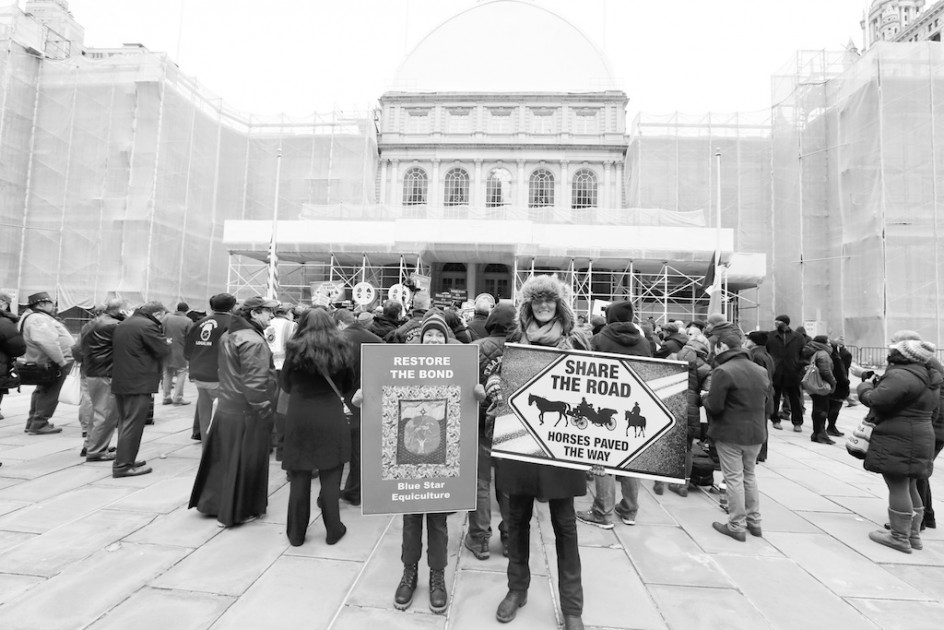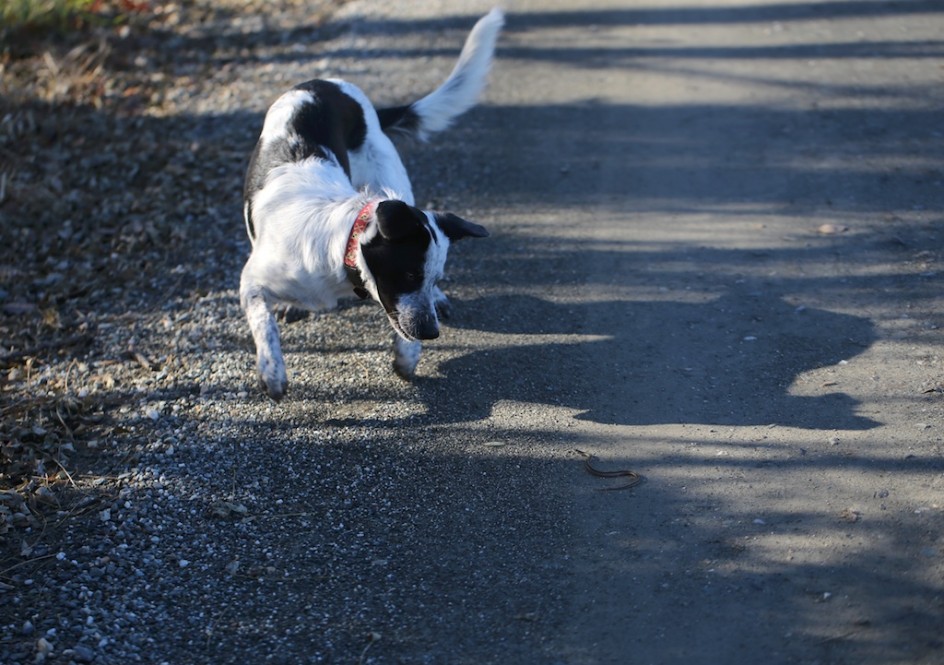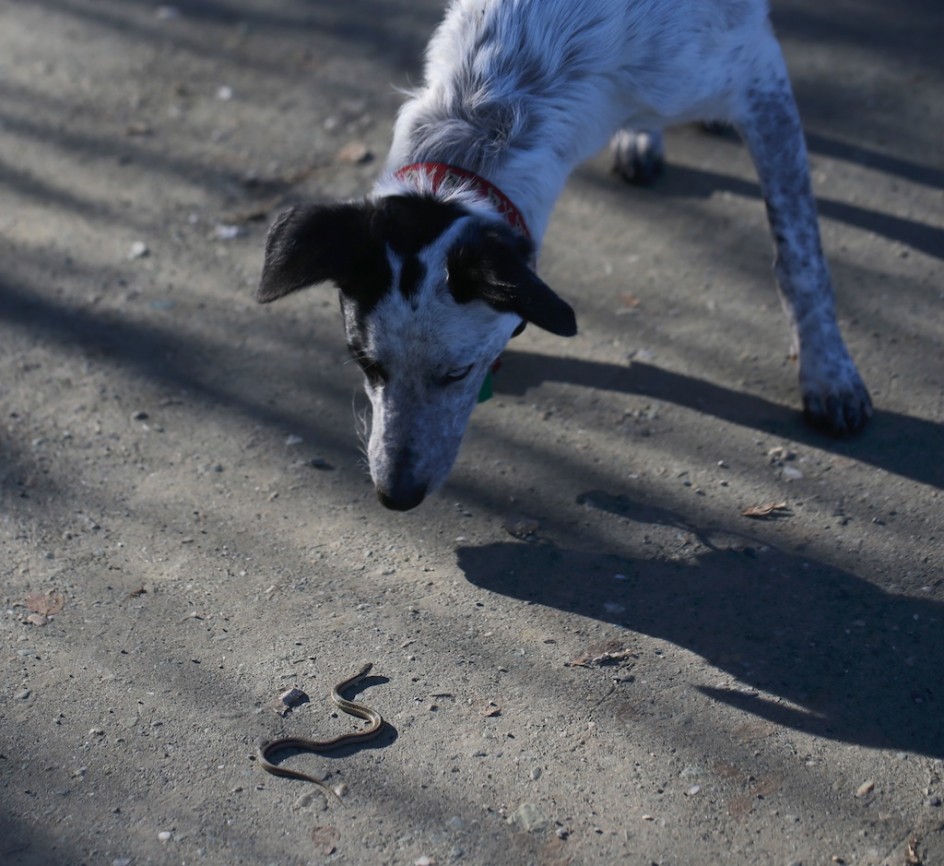
There are two ways to look at the New York Carriage Horse controversy. One is to see the work of pulling carriage horses in New York as dangerous, exploitive and abusive to animals.
The other is to to see it as the horses salvation, the safest and most secure work draft horses have ever had. To see them as the luckiest horses in the world, a pleasure to people and a boon to the battered environment.
The two perspectives are radically different, and they reflect the increasingly polarizing philosophies that sometimes seem to be tearing American culture and politics apart. The animal world is no different.
There is no longer a common way of looking at anything in the world, the American way of exploring issues is fragmented into perpetually warring, rigid and unyielding ideologies. The carriage horses are right in the middle. Because the struggle is happening in New York City, it is awakening the people in the animal world everywhere to the realization that the very existence of animals in our world is in real doubt. No one is really speaking for them. It has never been more important to try to understand where the real danger to them exists.
One woman messaged me to say it was a tragedy that the horses remain in such great danger in the city after the effort to ban them failed. How curious, I thought, I keep thinking how fortunate the carriage horses are to have been saved from slaughter and exile by getting to stay in their safe and regulated jobs. Were both of us following the same issue?
If we don’t understand or agree on the danger, how can we possibly help to save the animals? And who, when all is said and done, gets to speak for them?
The carriage horse controversy has highlighted the great divide in the animal world – for lack of better words, it is between the idea of animal welfare and the idea of animal rights. Another way to see it is as a widening conflict between the way urban America sees animals, and rural and mainstream America understands them. I can find very few horse owners or lovers who believe it is cruel for a draft horse to pull a carriage in New York’s Central Park.
The idea that it is dangerous for horses to be in crowded cities or to navigate busy streets clogged with automobiles is essentially an urban idea, a very new way of defining cruelty to animals. The demonstrators protesting the carriage trade are not horse people or animal people, they are essentially urban people. They live with pets – dogs and cats primarily, many of them rescued animals.
The mayor of New York, once so passionate about banning the horses, has never ridden one or owned a horse, he has never lived with a dog or cat, visited a horse stable or talked with a carriage driver. The people who protest the treatment of the horses – I have spoken to a number of them – are generally part of the pet animal culture in the city, they refuse to touch the horses, approach them, bring them carrots or apples, a curious attitude for animal lovers. Their politics seem curiously detached and viscerally ideological. Theirs seems often to be a culture of victimization, their identification with the horses is as victims, not companions, they tend to see them as more victims of abusive and greedy males.
It is rare to hear this point of view in any rural area, or from people who live and work with domesticated animals. I’ve never heard a farmer express it, or a horse owner. I’ve not met a veterinarian who agrees with it, or a behaviorist. In fact, Jared Diamond, perhaps the most famous biologist in the world, said in his important work (“Guns, Gems and Steel: The Fates Of Human Societies,” W.W. Norton, 1997) that “horses were the perfect domesticable animals with dominance hierarchies, a tolerance for other species, genetic malleability, and herding instincts.”
This is not what the animal rights spokespeople have been saying about the carriage horses, who they portray as dangerous, skittish, unstable. The media has eagerly transmitted these notions. No journalist in New York City has ever quoted him or messaged Diamond or called him up to ask him about the carriage horses.
The animal rights activists are convinced that it is cruel for the horses to be in the city at all, let alone to be pulling carriages. The actor Alec Baldwin, a supporter of animal rights, has called the carriages “torture wagons.” The animal rights movement does not believe animals should be used to make money for people, or to entertain them. They believe they should be returned to nature, or failing that, to rescue farms and preserves where they will never be asked or permitted to work.
They are not immune from politics, though, they never speak of the mounted police horses who patrol the crowded city daily in heavy traffic and in far more dangerous situations than a carriage horse will ever face.
The horse establishment – equine, veterinarians, behaviorists, equine journalists, trainers, horse lovers and breeders – are nearly unanimous in the belief that the danger to horses comes not from working in the city, but from having no work to do, in cities or elsewhere. Draft horses, they believe, like border collies, need to work to be healthy. They were bred to work, have always worked, and have never lived in nature or in the wild, they could not survive there. Working animals without work are are prone to immune disorders, depression, anxiety, aggression, and poor muscle development.
“It is the right of nonhuman working animals to work,” one Chicago horse vet told me.
The horses that are in danger, they say, are not the ones being fed and sheltered and cared for every day, but the ones who languish in private residences or farms, with little exercise, nothing to do, no people to attach to or bond with. Horses and people have been working together since the beginning of recorded history, it has never in all that time been considered cruel for horses to work. Until the last few decades in America.
There is precious little evidence to support the idea that pulling carriages in New York City is dangerous. Actually, there seems to be none.
A hundred years ago, between five and six thousand draft horses died in New York City every month, from overwork, disease, infection, starvation, fires, rodents and flies, potholes, accidents collisions, and wolves and other predators. The lives of city horses has improved beyond imagination. In the past 30 years, three carriage horses have died in traffic accidents out of approximately 3 million trips. Compared to the injuries afflicting people in New York, the horses are the safest living things in the city.
Last January, the two most prestigious equine veterinary groups in America joined the debate, sharing their findings about the carriage horses: they were safe and well cared for, safer than horses anywhere. There was no evidence of respiratory disease, abuse, overwork or any other kind of injury or illness coming from their work.
Why won’t the animal rights groups believe them? Because, like the climate change deniers, they don’t care for any science that disagrees with them.
I have read these reports and find them exhaustive and detailed and compelling. The animal rights groups arguing for a ban on the carriage trade really offer no scientific or factual evidence at all, other than their deep-seated and unyielding belief that it is simply wrong for animals to work, especially in cities. Their spokespeople are TV and pop music celebrities, not behaviorists or veterinarians.
In New York, one animal rights spokesperson after another argued that the horses should live in the wild. It is an Orwellian conversation. Neither they nor the reporters who quoted them seem to know that these horses have never lived in the wild, there is no wild now, and it was never safe there. The proponents of the carriage horse ban have never offered any detailed evidence of any kind that the horses are actually in danger, nor has the news media in New York City pressed them for any.
How could a movement that says it speaks for the rights of animals get it so wrong? While nine billion animals languish in sometimes horrific conditions on industrial factory animals farms, they spend millions of dollars on horses who are secure and well cared for. This movement is failing both animals and the people who love them.
To understand the conflict, it is important to understand the roots of the animal rights movement. Peter Singer, one of the founders of the movement, says in his landmark book “Animal Liberation: The Definitive Classic Of The Animal Movement,” that the ethical principle on which human equality rests requires us to extend equal consideration to animals, too.” And to accord them equal status when it comes to legislating their rights and care.
The movement came out of the liberation movements of the 1970’s on behalf of women and gay and transgender people and minorities. Singer compares the struggle for human rights and non-human rights and argues that even though people and animals are different, they are entitled to the same rights. It is a very stirring idea, I was drawn towards it, I very much supported the animal rights movement.
Animals should not be owned by people, used for research, Singer argued, or mistreated by them, they should be returned to their natural lives. Since the 1970’s, though two things have become clear.
“It is an implication of this principle of equality,” he wrote,” that our concern for others and our readiness to consider their interests ought not to depend on what they are like or on what abilities they may possess.” The basic principles of equality must, he argued, be extended to all beings, black or white, masculine or feminine, human or nonhuman.
It is a very compelling idea – animals should not be abused, they should be treated humanely and live freely. Who, after all, favors the abuse of animals?
But the world has evolved in a more complicated way. For one thing, there is no wild any longer for animals to be returned to. For another, climate change is destroying the remaining shrinking habitats of animals, and is pushing them out of the world. If animals are to survive, to be liberated and granted equal treatment, they must be extended the most basic right there is – the same opportunity human beings have to remain on the earth. That means we must find work for them whenever possible, and treat them as well as we possibly can.
Isn’t this what the carriage trade in New York has done?
The animal rights movement was not founded by people who understood the real lives of animals and could argue for what they needed, it has always been a purely detached and ideological movement founded by academics and urban dwellers who were – and are – far removed from the lives of animals.
The horses are not the only animals in danger. The animal rights movement has long pursued the elephants in the circuses and the ponies in farmer’s markets giving rides to children, and they have been successful in banning both. The well-meaning people who support these bans do not seem to know or ask where these animals will go when they are driven from their work. Does anyone really think there is a place for hundreds of unemployed Asian elephants whose habitats have all been destroyed to go?
The great conundrum of the carriage horse controversy is that the horses were granted better rights than most human workers. My favorite e-mail during the carriage horse controversy was from an Amazon warehouse worker, who said he would love to have the five weeks of vacation the carriage horses get and the working conditions they live under.
Stung by real accusations of mistreatment and abuse in the 1980’s, the carriage trade itself proposed sweeping regulations to guarantee the good treatment of the horses and the city adopted them: limits to working in heat and cold, limits on hours, regularly checks by police and veterinarians. Five different city agencies now supervise their care, and scores of respected, experienced, independent veterinarians and behaviorists have traveled to New York to examine the horses. Not a one has found them to be unhealthy or abused.
Horses who are not pulling carriages in New York are not faring nearly as well. About 150,000 each year are sent to slaughter in Canada and Mexico, economic issues have left countless others facing starvation, abandonment, lack of shelter and medical care all over the country. Rescue farms everywhere in America are overwhelmed, closing, overcrowded and desperate for resources. Is this the better life for the horses the mayor of New York was fighting for?
The safest horses anywhere are the carriage horses, who are themselves almost all rescued from auctions, closely regulated, much loved and well cared for. As importantly, they have important and popular work, which not only provides food for hundreds of families but ensures they will not be discarded and made extinct, as has happened to half of the animal species on the earth since 1970, according to the World Wildlife Fund.
The emerging truth of the carriage horse controversy was not that the horses were abused, it was that they are not.
Work not only does not put them in danger, it keeps them from it. The horses that lived in the American wild have all perished, done in by predators, development and the fact that people had no work for the horses of the prairie to do. Work doesn’t mean danger to draft horses, it means survival.
It seems that the entire horse community – owners, lovers, vets, trainers – knows and understands this. The urban ideologues calling for carriage ban and they politicians they bribe with boatloads of money do not seem to know it or want to learn anything about it. As a result of this myopia and extremism, the vast majority of New Yorkers united around the idea that the horses were fine, that they are safe and important to the city – more than two-thirds of the city’s residents. All three newspapers opposed the ban, so did labor and commerce, and the opposition was so intense that the mayor of New York, who promised to ban the horses on “day one” of his administration, fled from the fight over the summer. His ban was stillborn, it was never even introduced to a normally weak and acquiescent City Council.
The horses aren’t going anywhere. Animals mean something to people In crowded cities, they are desperately needed. Does anyone really think that New Yorkers, of all people, would support an industry that regularly abused and tortured it’s animals?
This all leaves the horses and other animals in a dangerously vulnerable position. The carriage horses nearly paid for this with their lives. If the movement that claims to speak for their rights is alienated from the mainstream of the animal culture and doesn’t seem to know much about animals, then who, precisely, will speak up for them and the very real dangers animals face?
Unfortunately, most animals don’t have the Teamsters going to bat for them. The people who love them and want to see them remain in our world will have to do it. I believe the carriage horse controversy has sparked a new social awakening, a new kind of movement to speak for animals is beginning to emerge. It is more contemporary, knowing and less angry and rigid that the contemporary animal rights movement has become. It understands that any movement that uses the love of animals to batter and hate people will ultimately fail.
The new movement supports science and expertise rather than liberation theology, which is great for people, but not so good for the non-humans Peter Singer wrote about a generation ago. It turns out that animals are not at all like people, and they cannot speak out and lobby and demonstrate for themselves, or speak of their own needs and welfare.
So we have to do it for them. That is, by definition, an unequal relationship. It is our responsibility. I think that is the new mandate and true challenge for the new and very necessary movement to save the animals in our world. The carriage horses started it.


